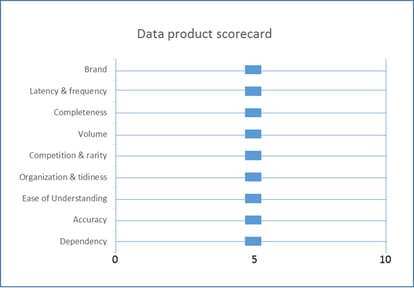Hello, again! This is the third part of our four-part series on pricing data products. So far, we have discussed the methods to price data as well as a a framework to thoroughly understand customers and what value a data product is actually delivering to them. In this installment, we will discuss nine (9) different price-to-value tradeoffs that determine how a given data product will compare to a customer’s maximum willingness to pay. Many of these value drivers are influenced by customers expectations, i.e. what are minimum requirements or benchmarks for data products of a given type.
Read on for more on how to price data! As always, subscribe to our blog to stay informed and continue on below for detail on the nine pricing levers of a data product.
For illustrative purposes, we will create a fictional new data product for global weather forecasts (“New Weather Product”). An appropriate benchmark is the Global Forecast System that is published four (4) times per day by the US National Weather Service (“NWS”) and produces forecasts for up to 16 days in advance.We would like to emphasize again, that data Vendors should have target customers in mind when calibrating the pricing levers below in order to arrive at their data product’s price. Customers will likely have pre-existing benchmarks in mind when evaluating any data product.
Brand Strength
Brand strength refers to how recognizable and respected Vendors are with their target customers. The stronger association there is between a Vendor’s name and valuable use cases, the more confidence buyers will have with the Vendor’s products. Thus, a stronger brand allows a Vendor to charge a higher price relative to competition and alternatives.
It should be noted that a Vendor does not need to have a “household name” to have brand strength. Instead, the Vendor could have a passionate user community, strong reference cases or subject matter expertise.
For example, the Vendor of the New Weather Product may not be well known outside of the meteorologist community. However, the New Weather Product Vendor may be well-respected and supported by meteorologists enough to influence commercial buyers of the New Weather Product. In fact, meteorologists may base their analyses, research and references on New Weather Product, thereby strengthening the brand of New Weather Product even further.
Frequency
Frequency refers to the intervals between when data is captured, refreshed and distributed. For example, the NWS is published four times daily. If New Weather Product is published hourly, then it is delivering significant added value to users who are highly sensitive to weather patterns, such as maritime vessels, who need data at more frequent intervals. Thus higher frequency would command a higher price.
Latency refers to the promptness of when data product is distributed. For example, suppose New Weather Product published their forecasts and current weather conditions four (4) times daily, like the NWS forecasts. If current weather conditions are then published with a one hour delay, and if NWS has no delay, then New Weather Product is less valuable since it has no time advantage over the benchmark. New Weather Product would then be difficult to sell at a premium price point.
Completeness
The completeness of a data product refers to the quantity of useful data fields it contains. Each user is different and will likely be searching for different signals or measurements. If a data product can deliver all the critical information to a customer, then other data products are not necessary. Thus, a more complete data product generally delivers more utility to the target customers.
For example, the NWS benchmark may not give granular detail on the weather forecast, such as time, precipitation amount, wind direction, humidity and pollen count. This may not be necessary for most customers, but it may be necessary for the target customers of New Weather Product. This would be a point of differentiation for New Weather Product. If this is the case, then the target customers would then value the New Weather Product at a premium.
Volume
While completeness refers to the number of variable types, volume refers to the number of reported items or entries. Using the above example, New Weather Product’s volume could significantly increase if it included hourly predictions of the weather for each data field. At the same time, volume could significantly increase if New Weather Product reported information across a broader geography, such as multiple locations within a city rather than the city as a whole.
More volume in a data product generally translates into increased value because it provides more detail and leads to more actionable insights.
Competition and rarity
Competition refers to the substitutes and competing data products available, either on DataStreamX or elsewhere. As with most products, more competition typically decreases the price a Vendor is capable of charging. With the New Weather Product example, the NWS is a direct competitor. If all other factors held equal and there was no differentiation from NWS, then the ability to charge a premium price for New Weather Product would be compromised.
Rarity refers to a data product’s uniqueness and ability to be replicated by another party. Proprietary data can be extremely rare, and if useful, can command a significant premium. For example, if the New Weather Product has exclusive rights to certain weather measurements, such as pollution levels, then it will be extremely rare. This rarity provide New Weather Product considerable market leverage and ability to charge a premium.
Organization and tidiness
Organization and tidiness refers to how the data product is compiled and delivered to users. Buyers will use data products in various ways, such as inputting the information into models or joining with other data sources. If the data product is in a format that is readily consumed, then it requires less preparation and is thus more valuable. For example, if the New Weather Product is output as an image or PDF unreadable by machines, then it may not be of any use to buyers since the cost of using the data product outweighs its benefits.
Organization and tidiness also refers to the consistency of the format of the data product. Data Vendors should maintain a consistent structure to their data products so that buyers won’t have to change the models, processes and analyses developed based upon prior data products. In the case of our New Weather Product, if city weather is reported using four components, then it should maintain this structure and not change to only report three components. This would frustrate and confuse buyers.
Additionally, numeric format should be consistent. For example, if one million is reported as “1.000” in the new economic data product, then ten thousand should be reported as “0.010”.
Sloppy, shifting or difficult to manipulate data products may deter potential buyers, particularly if they require a significant investment of time to use or maintain. As such, buyers’ willingness to pay for sloppy data products will fall.
Ease of understanding
Ease of understanding refers to how self-explanatory a data product is to a buyer. Clear and detailed documentation vastly improves the ease of understanding. All data products must have documentation provided by the data Vendor. Clear documentation is important for two reasons: marketability and usability.
In terms of marketability, clearer documentation leads to better understanding and application. When buyers are able to clearly understand what a data product is and how to use it, then the more likely they will be to purchase it.
For usability, clear documentation is especially important if the data fields are not formatted to generally accepted industry standards. Likewise, all data should be clearly marked and labeled so that the users can understand the units of measurement.
Generally, the less clear a data product is, the less valuable it is to a user.
For example, New Weather Product may measure wind speed with a propriety unit of measure: NPS. Whereas, the NWS benchmark measures output in miles per hour. A user would have to know exactly how to convert NPS into miles or kilometers per hour. This should be detailed both in the documentation and clearly marked within the data set. So long as the user can understand the information contained in the new economic data product, then he or she won’t discount the value relative to NWS.
Accuracy
Accuracy refers to how correct the data product is. Many times, accuracy is gauged by the ability to indicate relative conditions such as with a tracking index. For other circumstances, accuracy is an absolute measure such as with temperature, GPS and stock prices.
Customers will determine their tolerance levels regarding data accuracy. Accuracy is easily evaluated by a data product’s competition and how often the data is revised or restated. For example, New Weather Product may be more accurate than the NWS because its forecasts are rarely revised and have a higher rate of correctly predicting future weather events. If true, then it would be more reliable than the NWS forecasts.
Dependency
Dependency refers to the critical nature of the data product for the buyers’ use cases. If decisions cannot be made without the data product, then dependency is high, and the data producer can charge a higher price for it. However, if the data product can help make more accurate decisions, but is simply a “nice to have” feature, then the data still has value, but the buyer’s willingness to pay for it will be lower.
For example, commercial fishing fleets need weather data to plan routes and manage risk. If New Weather Product provides the most up-to-date and accurate weather information, then there would be a high dependency (and value) for customers involved in commercial fishing.
Looking at pricing levers is very introspective—it requires Vendors to honestly assess how they believe customers will perceive the data products. After scoring their own product, Vendors would be wise to score the competition data products available. This will help Vendors visualize how the data product compares to reference products—for both price and value. We enroucage all Vendors to score their products across the nine levers discussed above accoring to their benchmarks.
The DataStreamX scorecard is based on a scale of 1 to 10. ‘10’ indicates the product ranks at the highest level of customer expectations. Conversely, ‘0’ indicates the product ranks at the lowest level of customer expectations. ‘5’ indicates the product is generally acceptable for customers. The table below defines these rankings in more detail. Vendors who have completed the "Knowing the Customer" exercise in my prior blog post should have a general idea of how to score each of these levers.

In the next, and last, installment of this pricing series, we will discuss how to set a data product pricing strategy. You can alway skip ahead and download our complete pricing guide below. As always, we encourage anyone interested in joining the data economy to register with DataStreamX and browse our marketplace. Check us out at www.datastreamx.com today!


